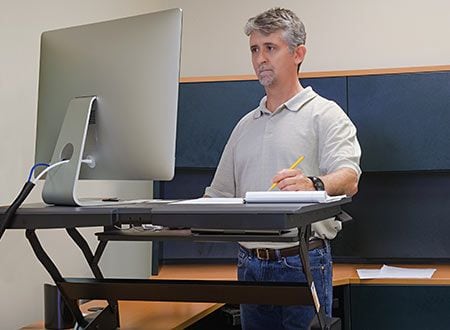
Ergonomics is the study of how safely, comfortably and efficiently people work in their professional environments. Because work environments are sometimes physically demanding or involve constant sitting with repetitive hand or wrist movements, many workers suffer from physical symptoms like pain and stiffness. When a workspace is not properly arranged, workers may develop weak postural muscles, find it hard to sit up straight, end up with poor standing posture, suffer from pain and tight muscles of the neck, shoulders and back, experience wrist, hand or arm pain, and be at increased risk of injury. A person's individual risk factors, the conditions of their workplace and the equipment they use are all contributing factors in determining how suitable a workspace is for maintaining good health.
Whether you spend your days sitting, driving or standing, there are likely some easy changes you can make to keep your body moving and feeling well.
Desk Work, Computer Work and Tablets/Handheld Device Work
Take frequent stretching breaks (at least once per hour for about 2 minutes) and move your head gently side to side, up and down, and ear to shoulder (on both sides), as well as lean backward, forward and side to side with your low back and hips to keep your joints and muscles from becoming achy and stiff.
Make sure your workspace setup is ergonomic (arranged so you can safely and efficiently interact with the things around you). There are a few things to keep in mind when creating your ergonomic setup:
- Place both feet flat on the floor with knees and ankles bent at 90 degrees. If your feet are unsupported, it is easy to slip into bad posture.
- Check your chair! You need good back and arm support. Arm rests should be high enough to support your forearms and elbows while keeping them at a 90-degree angle. If your office chair leaves you feeling hunched over or like your lower back is not well supported, consider some lumbar (low back) support. Lumbar support cushions are available to purchase, but you can also make your own with a rolled-up towel and a couple of rubber bands. Fold a small bath towel in half lengthwise, then roll from one short side to the other and secure the ends with rubber bands. Place the roll in the small of your back while sitting in your chair; you should feel supported in your low back without feeling pushed too far forward.
- Avoid reaching too far forward, which would put strain on the neck, shoulders and middle back, or pulling too far backward, which would put strain on the neck, shoulders and chest.
- Keep your eyes level with the top third portion of your monitor. Ergonomic aids like a bigger monitor attached to your laptop can keep your eyes level with the screen. Or try a standing desk to keep you from slouching over your keyboard.
- Make sure your screen is placed in front of you, about arm's length away, so you are looking at it directly, not off to one side or the other. If your screen is placed diagonally from your chair, it can create stress through the entire spine and may also cause muscle strain and sometimes headaches. If you have a dual screen monitor, position the screens so that they are touching and your nose is centered between them.
- If you are using a tablet or handheld device, hold it in front of you and high enough that you don't have to tilt your head forward or backward to see the screen. Try to rest your elbows on a hard surface to keep your arms supported while using your device.
- Consider using wrist supports to make your sitting workplace more comfortable. These supports are designed to keep your wrists parallel with the floor and your arms straight, to help protect you from developing a repetitive stress injury like carpal tunnel syndrome. Avoid deviating the wrists outward or extending the wrists. Maintain them in a neutral position. If that is not achieved with your current mouse or keyboard, it may be helpful to look into an ergonomic-friendly keyboard and mouse.
Driving/Riding
Did you know that the way your car's seat is set up can really make a difference in how you feel when riding in the car? This can be important for day-to-day commutes or for long road trips. The backrest should be reclined to about 30 degrees (about the one o'clock position if you're looking at your seat from the side, outside the car). Adjust the lumbar support to make sure you have good low back support while sitting. Many seats do not have lumbar support and can contribute to pain and discomfort. If this is the case, a lumbar support or rolled-up towel (see above) is recommended.
If you have knee, leg or foot pain while driving, move the seat forward or backward to make sure you don't have to reach too far or bend the knee or ankle too much to reach the pedals. Lastly, check that your headrest is in the correct position—the top of the headrest should be at the height of the top of your ears, and as close to the back of your head as possible. Having the headrest in the correct position will help protect your neck in case of an accident. If you are taking a long trip in the car, it's recommended to take a stretch break every few hours.
Standing
Standing desks are excellent for the workplace; however, if not used correctly, they can cause just as many problems for a person as sitting. If you are going from sitting in a chair all day to standing, it is important to gradually incorporate your standing desk into your work routine. Start off by standing a total of 10 minutes every hour and sitting for the remaining minutes. Slowly start to increase the amount of time you stand in a day to allow your body to adapt to the change.
Some of the same ideas for a well-designed seated workspace apply to a standing workspace: Make sure whatever you are working on is directly in front of you to avoid turning or leaning to one side over and over. When possible, stand on a cushioned surface, whether an “anti-fatigue” mat or flooring or in a comfortable and supportive shoe. This will help reduce pressure on the joints and muscles in your legs. Standing in one position for some time can decrease blood flow to the muscles that are working to keep you standing. Consider taking a two-minute break each hour to move around and get the blood flowing better to your legs and feet!
Some easy and inexpensive changes to your posture and workspace may help significantly relieve tension and physical stress on your body and reduce pain! You can always ask us about appropriate modifications for your unique situation.


